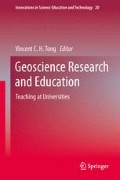Abstract
Geoscience has a long history of scholarly publication about education and learning. Over time, this work has covered both pedagogical and research findings. Pedagogical findings, related to educational settings, may be most clearly classified as “geoscience education,” while research findings in any setting can be grouped under the heading of “geocognition.” A new domain of scholarship in geocognition, the interdisciplinary study of how people perceive and understand Earth, has clearly emerged. Publication of research into cognitive, affective, or psychomotor processes that relate to human interaction with the Earth, including in educational settings, is occurring in a wide range of journals. Referencing rates within exemplar journals, such as the Journal of Geoscience Education, indicate both areas that the community values, such as learning science, as well as disconnects between geocognition and related communities in other sciences. Research findings need to be communicated among geocognition researchers, to similar scholars in other science domains, and to geoscientists in general. Interdisciplinary communication and oversight may be the most effective pathway to ensuring that geocognition research disseminated to broader scientific communities is of the highest quality.
Access this chapter
Tax calculation will be finalised at checkout
Purchases are for personal use only
References
Feig, A. D. (2010). Technology, accuracy and scientific thought in field camp: An ethnographic study. Journal of Geoscience Education, 58, 241–251.
Forbus, K., Usher, J., Lovett, A., et al. (2011). CogSketch: Sketch understanding for cognitive science research and for education. Topics in Cognitive Science, 3, 648–666. doi:10.1111/j.1756-8765.2011.01149.x.
Good, G. A. (2000). The assembly of geophysics: Scientific disciplines as frameworks of consensus. Studies in History and Philosophy of Science Part B: Studies in History and Philosophy of Modern Physics, 31, 259–292. doi:10.1016/S1355-2198(00)00018-6.
Hambrick, D. Z., Libarkin, J. C., Petcovic, H. L., et al. (2011). A test of the circumvention-of-limits hypothesis in scientific problem solving: The case of geological bedrock mapping. Journal of Experimental Psychology: General. doi:10.1037/a0025927.
Hmelo-Silver, C. E., Marathe, S., & Liu, L. (2007). Fish swim, rocks sit, and lungs breathe: Expert-novice understanding of complex systems. Journal of the Learning Sciences, 16, 307–331. doi:10.1080/10508400701413401.
Kelemen, D., & Rosset, E. (2009). The human function compunction: Teleological explanation in adults. Cognition, 111, 138–143.
Lewis, E. B., & Baker, D. R. (2009). A call for a new geoscience education research agenda. Journal of Research in Science Teaching, 47, n/a–n/a. doi: 10.1002/tea.20320
Libarkin, J. C. (2006). Geoscience education in the United States. Planet Special Issue on Threshold Concepts and Troublesome Knowledge, 60.
Libarkin, J. C., & Kurdziel, J. P. (2006). Ontology and the teaching of earth system science. Journal of Geoscience Education, 54, 408.
Libarkin, J. C., Ward, E. M. G., Anderson, S. W., et al. (2011). Revisiting the geoscience concept inventory: A call to the community. GSA Today, 21, 26–28. doi:10.1130/G110GW.1.
Lin, M.-C., Tutwiler, M. S., & Chang, C.-Y. (2011). Exploring the relationship between virtual learning environment preference, use, and learning outcomes in 10th grade earth science students. Learning, Media and Technology, 36, 399–417. doi:10.1080/17439884.2011.629660.
Odum, E. P. (1977). The emergence of ecology as a new integrative discipline. Science, 195, 1289–1293.
Stokes, A., & Feig, A. (2011). Qualitative inquiry in geoscience education research (Special papers, Geological Society of America). Boulder: Geological Society of America.
Titus, S., & Horsman, E. (2009). Characterizing and improving spatial visualization skills. Journal of Geoscience Education, 57, 242–254.
Trend, R. (2005). Individual, situational and topic interest in geoscience among 11- and 12-year-old children. Research Papers in Education, 20, 271–302. doi:10.1080/02671520500193843.
Author information
Authors and Affiliations
Corresponding author
Editor information
Editors and Affiliations
Rights and permissions
Copyright information
© 2014 Springer Science+Business Media Dordrecht
About this chapter
Cite this chapter
Libarkin, J. (2014). The Role of Scholarly Publication in Geocognition and Discipline-Based Geoscience Education Research. In: Tong, V. (eds) Geoscience Research and Education. Innovations in Science Education and Technology, vol 20. Springer, Dordrecht. https://doi.org/10.1007/978-94-007-6946-5_7
Download citation
DOI: https://doi.org/10.1007/978-94-007-6946-5_7
Published:
Publisher Name: Springer, Dordrecht
Print ISBN: 978-94-007-6945-8
Online ISBN: 978-94-007-6946-5
eBook Packages: Humanities, Social Sciences and LawEducation (R0)

